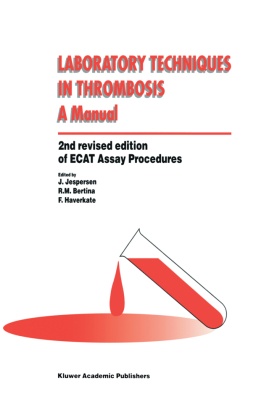
Laboratory Techniques in Thrombosis - a Manual
| Verlag | Springer Netherlands |
| Auflage | 1998 |
| Seiten | 308 |
| Format | 15,5 x 23,5 x 2,2 cm |
| Gewicht | 660 g |
| Artikeltyp | Englisches Buch |
| EAN | 9780792353171 |
| Bestell-Nr | 79235317EA |
The first edition of this manual appeared in 1992 and was entitled ECAT Assay Procedures. It was the result of a unique cooperation between experts brought together by the European Concerted Action on Thrombosis and Disabilities (ECAT). The Concerted Action was at that time under the auspices of the Commission of the European Union. The second edition, like the first edition, deals with diagnostic tests within the field of thrombosis. However, the second edition has a broader scope because it is no longer limited by the frontiers of ECAT. Experts allover the world, in and outside ECAT, have contributed to this edition. The editors are very grateful for their contributions. The need for a new edition is obvious. Since 1992 new assays have been introduced for research, diagnosis, and therapy of thrombosis; for other assays improvements have been suggested, while a few others became redundant. The editors waived the radioimmunoassays of ~-thrombog1obulin and platelet factor 4 due to the fact that the kits required for these assays are rarely, or no longer, available. Also the PAI-1 activity assay was waived as it is liable to many inconsistencies and to large variations. A list of names and addresses of manufacturers marketing the kits and reagents has been compiled, together with a list of the recommended nomenclature of quantities in thrombosis and haemostasis, in order to facilitate the use of the updated version. These lists have been carefully compiled by Johannes J. Sidelmann, PhD, Department of Clinical Biochemistry in Esbjerg, Denmark.
Inhaltsverzeichnis:
1 Introduction to laboratory assays in haemostasis and thrombosis.- 2 Good medical laboratory services - guidelines.- 3 Blood collection and sample preparation: pre-analytical variation.- 4 Quality assessment of haemostatic assays and external quality assessment schemes.- 5 Activated partial thromboplastin time (APTT).- 6 Prothrombin time (PT).- 7 Endogenous thrombin potential.- 8 Fibrinogen.- 9 Activated factor VII.- 10 Factor VII activity and antigen.- 11 Factor VIII clotting activity.- 12 Von Willebrand factor.- 13 Antithrombin activity and antigen.- 14 Protein C activity and antigen.- 15 Protein S antigen.- 16 Protein S activity.- 17 Activated protein C (APC) resistance.- 18 Tissue factor pathway inhibitor (TFPI).- 19 Lupus anticoagulant.- 20 Heparin cofactor II.- 21 Fibrinopeptide A (FPA).- 22 Thrombin-antithrombin (TAT) complexes.- 23 Prothrombin fragment F1+2.- 24 Tissue-type plasminogen activator (t-PA) activity.- 25 Tissue-type plasminogen activator antigen (t-PA Ag).- 26 Plasminogen activator inhibitor-1 (PAI-1) antigen.- "10.1007/978-94-011-4722-4_27".- 28 Plasmin inhibitor activity (previously ?2-antiplasmin).- 29 Plasmin-?2-antiplasmin complexes (plasmin-plasmin inhibitor complexes).- 30 Soluble fibrin and degradation products of fibrinogen (FgDP), fibrin (FbDP; D-dimer) and total of FgDP and FbDP (TDP).- 31 Venous occlusion test in fibrinolysis assays.- 32 List of manufacturers.
Rezension:
`The objective towards standardization is largely met, since world experts on each assay collaborated to evaluate and compare the available methodologies and point to the advantages and disadvantages of each one. This book is written for clinical thrombosis and hemostasis laboratorians. Another attractive feature is the degree of expertise recruited to produce these critical summaries of existing methodologies. This book is a long overdue update of the first edition in view of the multitude of newly developed methodologies and the number of manufacturers involved.'
Demetra D. Callas, Loyola University Medical Center in Doody Publishing Inc.
